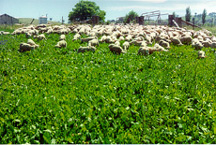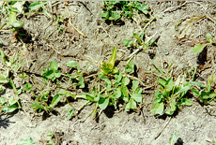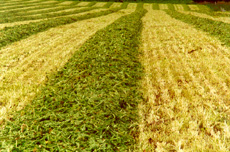
Chicory Part D - Management of chicory
Fertiliser at establishment and for maintenance
As with all pastures, soil tests are recommended before fertiliser strategies are decided. Fertiliser requirements will vary with soil type, climate and previous management. Strategic fertiliser applications may be required to maintain optimal herbage quantity. Advice on interpretation of soil test results is available from NSW Department of Primary Industries (NSW DPI) agronomists.
The following is only a guide: Early-spring-applied maintenance rates of 25–40 kg phosphorus (P), 20 kg potassium (K) and 20 kg sulfur (S) per hectare will help sustain high growth rates of chicory.
Chicory does not fix nitrogen. As with pastures, nitrogen (N) fertiliser applied at sowing is necessary to enable quick establishment. Where chicory is sown without legumes, nitrogenous fertiliser will be required on an ongoing basis to promote growth and herbage productivity. Even where companion legumes are used, an initial application of N, before rhizobia are effective, will be required — even where soil nitrogen levels are high. (Applications of nitrogen will be beneficial throughout the life of the chicory stand to boost N levels and productivity where companion legumes are found not to provide optimum levels.)
Application rates of N will depend upon paddock history and soil type; however, a minimum of 30 kg N/ha applied prior to or at sowing will aid establishment. Ensure that N is not placed in contact with seed at these rates.
A decline in herbage production without a corresponding decrease in plant numbers (leaves may also be paler) may indicate inadequate soil nitrogen. As a guide, two applications of 30 kg N/ha in spring will significantly boost growth and can be justified for high-value livestock enterprises. Under irrigation or in high summer rainfall, applications of N could also be warranted over summer. The use of suitable companion legumes to provide N for growth is beneficial. Nitrogen deficiency will often show up as leaf paleness or yellowing.
Being a highly productive species with a high mineral content, it is suspected that deficiencies in other nutrients may emerge in some soil types. If this is suspected, ask your local agronomist for advice.
Fertiliser usage will be largely determined by plant growth and product removal:
- In intensive grazing situations, higher fertiliser application will be required to replace the plant nutrients lost by grazing and plant utilisation.
- Where grazing is less intensive, lower fertiliser applications will be appropriate.
First grazing

Chicory is ready to be grazed when it reaches 150–200 mm in height (generally about 80–100 days after sowing) and the taproot is well established. Grazing should be delayed until plants are resistant to being pulled out. Grazing in the first year should be quick and light to avoid crown damage, and to encourage new shoots.
Four-paddock grazing system
A survey of growers with chicory pastures in central NSW found that chicory had declined significantly in half the continuously grazed mixed pastures, 4 years after sowing. In contrast, a high proportion of more carefully managed and special-purpose pastures had retained their chicory content 6 years after sowing. Research conducted at NSW DPI's Orange Agricultural Institute suggests that rotational grazing using at least four paddocks would be ideal for the persistence and productivity of chicory pastures. Aim to maintain a high density of chicory plants, with stands of 50–60 plants/m2.
A series of grazing rules has been developed:
- Don't graze any one paddock more than 2 weeks at a time, and don't graze below a herbage mass of 1500 kg DM/ha (approximately 5 cm) to protect the crowns.
- At times of fast growth (spring and summer), move stock onto the next paddock when plant heights are 30–50 cm, even if the paddock being currently grazed has not been fully utilised. Chicory should be grazed frequently enough (between rest periods of 3–4 weeks) to maintain a high proportion of leaf to stem, and to allow carbohydrate reserves to be replenished; that is, limit the stem growth.
- Chicory is particularly sensitive to grazing when plant growth has slowed. Grazing should be light from late autumn until early spring when growth rates have picked up, to avoid damage to the crowns and to minimise the risk of fungal infections. A quick graze and long rest is better than leaving the stock in for extended periods.
- If the chicory stand thins out (e.g. to less than 20 plants/m2), increase rest periods to 6 weeks or more over late spring and summer, to allow seed set and opportunities for chicory seedlings to establish. In dry years little recruitment is likely to occur, but reduced grazing pressure will enhance the survival of the existing chicory plants (see 'Seed production and pasture rejuvenation' below).
- In spring, slashing may be required to remove dead stems to allow stock access into the pasture. Ensure slashing does not occur before irrigation or rain, as slashed stems are prone to fungal infection.
Table D1. Potential animal performance: chicory vs other pasture species in summer
| Species | Weight gain lambs (g/day) |
|---|---|
| Ryegrass | 160–230 |
| Cocksfoot | -180 |
| Tall fescue | -260 |
| Chicory | 190–370 |
| Lucerne | 170–300 |
| Forage rape | 120–250 |
Source: NSW Department of Primary Industries, Agriculture Victoria, and Ag Research New Zealand.

In a four-paddock system using the above grazing rules, stock would be moved once a week when chicory is growing fast, giving each paddock a 3-week rest period. When chicory growth is slow, stock would be moved fortnightly, giving each paddock a 6-week rest period. The optimum stocking rate will vary due to site variations, seasonal conditions and between different climatic regions.
The photo at right shows a Puna chicory/white clover pasture after grazing — aim to leave 50% more plant material than this.
Seed production and pasture rejuvenation through plant recruitment
If chicory stands thin out, it is possible to regenerate them by resting the paddock to encourage flowering and seed set from late summer through autumn. Sufficient rest is required to encourage seed set, and for the subsequent maturation of seed produced. Recruitment of new chicory plants will occur after adequate rainfall has enabled germination and establishment. Too short a break from grazing may result in only smaller and 'weedier' plant types setting seed, with subsequent poor results. If paddocks are limited it may be more suitable to resow in order to re-establish a new stand, rather than depend on recruitment.
Spring-sown chicory will not produce seed in the first year after establishment; however, chicory sown in autumn will set seed the following summer if cool-season requirements have been met. Flowering and seed set occurs over a period of about 8–10 weeks.
Fodder conservation
Haymaking
Chicory by itself is not suitable for haymaking. As a component of a pasture, it can be baled successfully for conserved fodder. Chicory turns dark on drying and is very brittle and dusty. It should be baled under the same conditions as lucerne — when the leaves are slightly moist with dew to prevent losses from leaves turning to dust. As a general rule, do not depend on the chicory component to add significantly to hay quality or production.
Haylage/silage

Chicory has been successfully used for silage production for many years, and is suitable for pit silage and wrapped 'haylage'. The windrowed chicory (shown at right) will be chopped prior to placing it in a pit for silage. Care should be taken to ensure that cutting allows for a high proportion of leaf to stalk. Good quality chicory silage can be made by harvesting/baling at a slightly drier moisture content than is normal for pasture silage. Inoculant can be used successfully.
Pests and diseases
Earth mites can be a problem at establishment. After sowing, the pasture should be inspected twice a week for earth mites until the pasture is established.
White fringe weevil can cause plant losses, especially when plants are under moisture stress.
IMAGE NOT FOUND:14909 - may not be published
Where chicory is direct drilled, care should be taken to ensure that slugs do not cause serious losses. Experience in Victoria and recently in the Southern Tablelands in NSW has demonstrated that early-spring-sown chicory can be extremely vulnerable to slugs moving down freshly sown drill tracks. Where slugs are anticipated, chemical control can be achieved via pellets either through the seed drill, or broadcast separately.
So far, two diseases, charcoal rot (see photo at right) and sclerotinia, have been found in chicory. For this reason it is advisable not to establish chicory after sclerotinia-susceptible crops, for example pulse crops, lucerne, canola etc.
Slashing should be avoided in autumn and winter because water pools in the hollow stems when the chicory is not actively growing, which may create favourable conditions for disease infection.
Cautions
Always read the label
Users of agricultural (or veterinary) chemical products must always read the label and any Permit before using the product, and strictly comply with the directions on the label and the conditions of any Permit. Users are not absolved from compliance with the directions on the label or the conditions of the permit by reason of any statement made or omitted to be made in this publication.
Pasture improvement
Pasture improvement may be associated with an increase in the incidence of certain livestock health disorders. Livestock and production losses from some disorders is possible. Management may need to be modified to minimise risk. Consult your veterinarian or adviser when planning pasture improvement.
The Native Vegetation Conservation Act 1997 restricts some pasture improvement practices where existing pasture contains native species. Inquire through your office of the Department of Infrastructure, Planning and Natural Resources (DIPNR).
Further information
For further information on chicory, see the other parts of Agfact P2.5.40:

